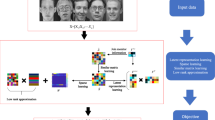Abstract
Multi-metric learning is important for improving classification performance since learning a single metric is usually insufficient for complex data. The existing multi-metric learning methods are based on the triplet constraints, and thus are with high computing complexity. In this work, we propose an efficient multi-metric learning framework by a pair of two-metric learning schemes (called TMML) to jointly train two local metrics and a global metric, where the distances between samples are automatically adjusted to maximize classification margin. Instead of the triplet constraints, the proposed TMML is based on the pair constraints to reduce the computational burden. Moreover, a global regularization is introduced to improve generalization and control overfitting. The proposed TMML improves the limitation of a single metric, where a pair of local metrics are interrelated to conduct adaptation for the local characteristics, while global metrics are to depict the common properties from all the data. Furthermore, we develop an alternating direction iterative algorithm to optimize the proposed TMML. The convergence of the algorithm is analyzed theoretically. Numerical experiments are carried out on different scale datasets. Under different evaluation criteria, experiments show that the proposed TMML is superior to the single metric learning methods, and achieves better performance than other state-of-the-art multi-metric learning methods in most cases.



Similar content being viewed by others
References
Davis J V, Kulis B, Jain P, Sra S, Dhillon I. S. (2007) Information-theoretic metric learning. In: Proceedings of the 24th international conference on Machine learning, pp 209–216
Dewei L., Yingjie T (2018) Survey and experimental study on metric learning methods. Neural Netw 105:447–462
Li C. H., Jing L., Li H (2014) Naive bayes for value difference metric. Front Comput Sci 8(2):255–264
Nguyen B, Baets BD (2018) An approach to supervised distance metric learning based on difference of convex functions programming. Pattern Recogn 81:562–574
Zadeh P. H., Hosseini R., Sra S. (2016) Geometric mean metric learning. In: international conference on machine learning (ICML), pp 2464–2471
Ye H J, Zhan D., Li CN, Jiang Y (2020) Learning multiple local metrics: Global consideration helps. IEEE Trans Pattern Anal Mach Intell 42(7):1968–1712
Li C H, Jing L, Li H., Wu J., Zhang P (2017) Toward value difference metric with attribute weighting. Knowl Inf Syst 50(3):795–825
Noh Y K, Zhang BT, Lee DD (2018) Generative local metric learning for nearest neighbor classification. IEEE Trans Pattern Anal Mach Intell 40(1):106–118
Dong M, Wang Y, Yang X et al (2018) Learning Local Metrics and Influential Regions for Classification. IEEE Trans Pattern Anal Mach Intell:1–8. https://doi.org/10.1109/TPAMI.2019.2914899
Ye H J, Zhan DC, Jiang Y et al (2019) What makes objects similar: a unified Multi-Metric learning approach. IEEE Trans Pattern Anal Mach Intell 41(5):1257–1270
Bac N, Ferri F J, Carlos M, Bernard D B (2019) An efficient method for clustered multi-metric learning. Inf Sci 471:149– 163
Zuo W, Wang F, Zhang D, Lin L, Huang Y, Meng D, Zhang L (2017) Distance metric learning via iterated support vector machines. IEEE Trans Image Process 99:1–1
Shichao Kan A, Shichao K, zhang L, He ZH, Cen Y, Chen SH, Zhou J et al (2020) Metric learning-based kernel transformer with triplets and label constraints for feature fusion. Pattern Recogn 99:107086
Meyer G, Bonnabel S, Sepulchre RJ (2011) Regression on Fixed-Rank Positive Semidefinite Matrices: A Riemannian Approach. J Mach Learn Res 12(3):593–625
Weinberger K Q, Saul L. K. (2009) Distance metric learning for large margin nearest neighbor classification. J Mach Learn Res 10(1):207–244
Weinberger K Q, Saul L. K. (2008) Fast solvers and efficient implementations for distance metric learning. Proceedings of the Twenty-Fifth International Conference on Machine Learning, pp 1160–1167
Liang J., Hu Q et al (2018) Efficient multi-modal geometric mean metric learning. Pattern Recogn 75:188–198
Li D. W., Tian Y. J. (2017) Global and local metric learning via eigenvectors. Knowl-Based Syst 116:152–162
Domeniconi C, Peng J, Gunopulos D. (2001) An Adaptive Metric Machine for Pattern Classification. In: Adv Neural Inf Process Syst 13:458-464
Bohne J, Ying Y, Gentric S, Pontil M. (2004) Large margin local metric learning. In: Proceedings of the European Conference on Computer Vision, pp 679–694
Ying Y, Li P (2012) Distance metric learning with eigenvalue optimization. J Mach Learn Res 13(1):1–26
Zuo W, Wang F, Zhang D, et al. (2017) Distance metric learning via iterated support vector machines. IEEE Trans Image Process 26(10):4937–4950
Wang F, Zuo W, Zhang L et al (2015) A kernel classification framework for metric learning. IEEE Trans Neural Netw Learn Syst 26(9):1950–1962
Dong M, Wang Y, Yang X, et al. (2018) Local metrics and influential regions for classification. IEEE Transactions on Pattern Analysis & Machine Intelligence
Parameswaran K. Q. (2010) Weinberger Large margin multi-task metric learning. In: Advances in neural information processing systems, pp 1867–1875
Shalev-Shwartz S, Singer Y, Srebro N , Cotter A (2011) Pegasos: primal estimated sub-gradient solver for SVM. Math Programm 127(1):3–30
Tseng P (2001) Convergence of a block coordinate descent method for nondifferentiable minimization. J Optim Theory Appl 109(3):475–494
Ruan Y., Xiao Y., Hao Z, Liu B (2021) A Convex Model for Distance Metric Learning. IEEE Trans Neural Netw Learn Syst: 1–14
Blake C, Merz C (1998) UCI Repository for Machine Learning Databases. http://www.ics.uci.edu/~mlearn/MLRepository.html
Chang C, Lin C (2001) LIBSVM data set. https://www.csie.ntu.edu.tw/~cjlin/libsvmtools/datasets/
Fawcett T (2006) An introduction to ROC analysis. Pattern Recogn Lett 27(8):861–874
Demisar J, Schuurmans D. (2006) Statistical comparisons of classifiers over multiple data sets. J Mach Learn Res 7(1):1–30
Dunn O. J. (1961) Multiple comparisons among means. J Am Stat Assoc 56(293):52–64
Wu Z., Zhu H., Li G, Cui Z, huang H, Li J, chen E, Xu G (2017) An efficient wikipedia semantic matching approach to text document classification. Inf Sci 393:15–28
Wu Z, Li G, Liu Q, Xu G, Che E (2018) Covering the sensitive subjects to protect personal privacy in personalized recommendation. IEEE Trans Serv Comput 11(3):493–506
Bai B., Li G., Wang S., Wu Z., Yan W (2021) Time series classification based on multi-feature dictionary representation and ensemble learning. Expert Syst Appl Expert Syst Appl 169:114162
Acknowledgements
This work is supported by National Nature Science Foundation of China (11471010, 11271367). Moreover, the authors thank the referees and editor for their constructive comments to improve the paper.
Author information
Authors and Affiliations
Corresponding author
Additional information
Publisher’s note
Springer Nature remains neutral with regard to jurisdictional claims in published maps and institutional affiliations.
Appendix:
Appendix:
Conditions to guarantee the convergence of block-coordinate descent method [27].
Assume that the objective function to be optimized has the following form:
Suppose that f,f0,f1,⋯ ,fN satisfy Assumptions B1-B3 and that f0 satisfies either the assumption C1 or C2. Also, assume that the sequence \(\{x^{r}=({x_{1}^{r}},\cdots ,{x_{N}^{r}})\}_{r=0,1,\cdots }\) generated by the BCD method using the essentially cyclic rule is defined. Then, either \(\{f(x^{r})\}\downarrow -\infty \), or else every cluster point z = (z1,⋯ ,zN) is a coordinatewise minimum point of f.
-
(B1)
f0 is continuous on dom f0.
-
(B2)
For each k ∈{1,⋯ ,N} and (xj)j≠k, the function \(x_{k}\rightarrow f(x_{1},\cdots ,x_{N})\) is quasiconvex and hemivariate.
-
(B3)
f0,f1,⋯ ,fN are lower semicontinuous.
-
(C1)
dom f0 is open and f0 tends to \(\infty \) at every boundary point of dom f0.
-
(C2)
dom f0 = Y1×,⋯ ,×YN, for some \(Y_{k} \subseteq R^{n_{k}},k=1,\cdots ,N\)
Theorem
[27]. Suppose that f,f0,⋯ ,fN satisfy assumptions B1-B3 and that f0 satisfies either assumption C1 or C2. Using the essentially cyclic, the block-coordinate descent method converges to an optimal point of f.
Rights and permissions
About this article
Cite this article
Zhang, M., Yang, L., Yuan, C. et al. Multi-metric learning by a pair of twin-metric learning framework. Appl Intell 52, 17490–17507 (2022). https://doi.org/10.1007/s10489-022-03330-9
Accepted:
Published:
Issue Date:
DOI: https://doi.org/10.1007/s10489-022-03330-9




